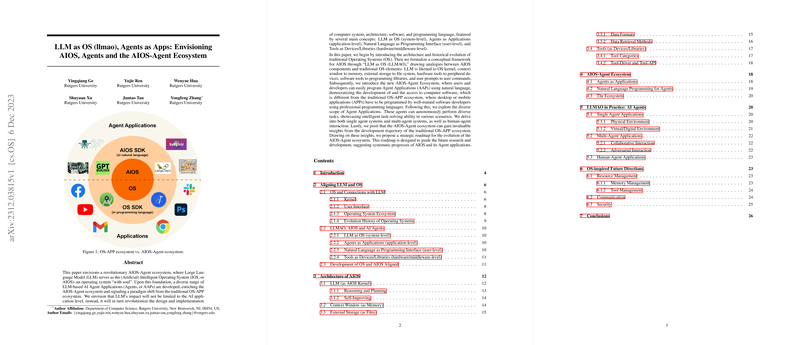Envisioning the Future of AIOS: LLMs as Operating Systems
Introduction
In recent years, the development of LLMs has paved the way for significant advancements in artificial intelligence. These models have shown remarkable capabilities in understanding and generating human-like text, suggesting a potential for broader applications beyond traditional tasks. A groundbreaking paper from Rutgers University explores the concept of (Artificial) Intelligent Operating Systems (AIOS), where LLMs serve as the foundation of an intelligent operating system. This novel concept suggests a shift from the traditional OS-APP ecosystem to an AIOS-Agent ecosystem, fundamentally altering how users interact with computer systems.
LLM as OS (LLMOS)
The paper introduces the concept of "LLM as OS (LLMOS)," proposing a new framework that mirrors traditional Operating Systems' architecture but with LLMs at its core. This framework suggests several analogies between AIOS components and conventional OS elements, with the LLM likened to the OS kernel and other components such as context windows and external storage mirroring memory and file systems, respectively. Notably, LLMOS reimagines device management by integrating both hardware and software tools to extend the LLM's capabilities, enabling it to interact with the digital and physical world effectively.
Reasoning and Planning in LLMOS
LLMOS aims to endow LLMs with sophisticated reasoning and planning abilities, drawing inspiration from classical problems like the Dining Philosophers problem to illustrate the parallels in resource allocation and synchronization within a multi-agent ecosystem. The paper discusses several strategies for enhancing LLMs' planning capabilities, including single-path planning though Chain of Thoughts and multi-path planning with Tree of Thoughts, showcasing the potential for more advanced reasoning and creative problem-solving within LLMOS.
Tool Management
Tools in LLMOS serve as a bridge between LLMs and their operational environment, expanding their capabilities. The discussion on tool categories emphasizes the importance of software and hardware tools, with notable examples like ToolCoder and SayCan illustrating the practical applications of these tools. Furthermore, the concept of self-made tools indicates a future where LLMs can not only use tools but also generate and improve them, pushing the boundaries of autonomous problem-solving.
AIOS-Agent Ecosystem
The AIOS-Agent ecosystem envisions an environment where users and developers can effortlessly create Agent Applications (AAPs) using natural language. This ecosystem promises to democratize software development by making it accessible to a broader audience without specialized programming knowledge. The paper elucidates single and multi-agent applications, highlighting scenarios in the physical and digital worlds where agents can autonomously or collaboratively perform complex tasks, thus showcasing the practical implications of this ecosystem.
Future Research and Development
Considering the evolution of traditional operating systems, the paper outlines several future directions for AIOS, focusing on memory and tool management, communication, and security. Drawing parallels with historical OS advancements, the authors suggest innovative approaches for enhancing LLMOS's resource management capabilities, developing standardized communication protocols, and addressing security vulnerabilities. These insights present a strategic roadmap for systematic progress in AIOS and agent application research, with an emphasis on learning from the traditional OS-APP ecosystem's development trajectory.
Conclusion
The conceptual framework for AIOS presented in this paper signals a transformative change in the field of artificial intelligence and operating systems. By positioning LLMs as the foundational element of intelligent operating systems, the authors propose a shift towards a more interactive, intuitive, and accessible computing paradigm. This ambitious vision for AIOS not only challenges conventional computing paradigms but also opens up new avenues for innovation, collaboration, and interaction between humans and intelligent systems. The proposed roadmap for future research and development underscore the potential for AIOS to revolutionize our interaction with technology, promising a future where the boundaries between human intelligence and artificial intelligence become increasingly blurred.
